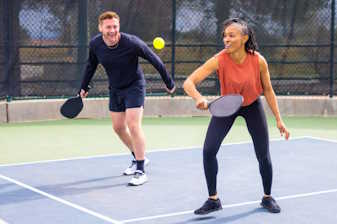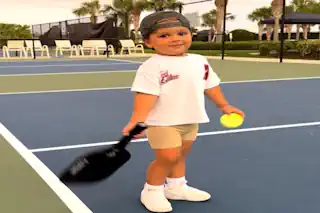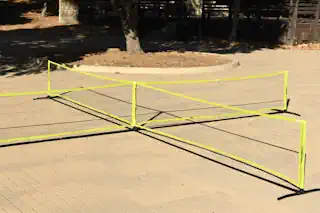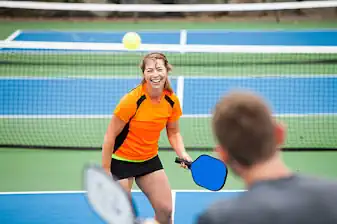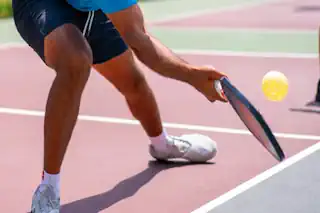Mastering the Pickleball Defense: 3 Drills for Unyielding Ds
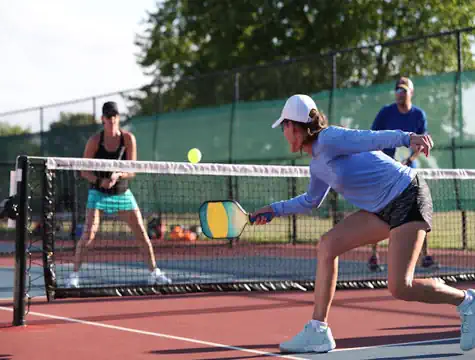
For the uninitiated, the game of pickleball might sound like an eccentric concoction, but to those familiar with the sport, it’s the recipe for a bracing physical and strategic encounter. If you’re already hooked on this fantastic blend of tennis, badminton, and table tennis, you understand the need for an impenetrable defense. Whether you’re just starting or have been smacking the plastic ball around for a while, this guide is for you—all about strengthening your defensive play with three key pickleball drills.
Being in the middle of the court in position anticipating your opponent’s next shot playing defensively and resetting in preparation to go on the offensive. Ask anyone and they will tell you their tips to master pickleball including drills to learn the difference between playing defensively in response to your opponent’s rhythm and force and when it is time to attack. Playing strategically and patiently and waiting for your opponent to make a mistake is a consistent defensive pattern resulting in winning.
The Defensive Dance: A Critical Component in Pickleball
In a game where finesse and sudden sprints to the ‘kitchen’ are as essential as they are frequent, mastering the art of defense is non-negotiable. Effective defensive play not only keeps you in the control of a rally but also sets the stage for offensive opportunities. It’s a delicate dance involving quick footwork, precise positioning, and the ability to read opponents’ intentions. In pickleball, a strong defense doesn’t just block smashes; it fulfills a multifaceted role in resetting the point in your favor.
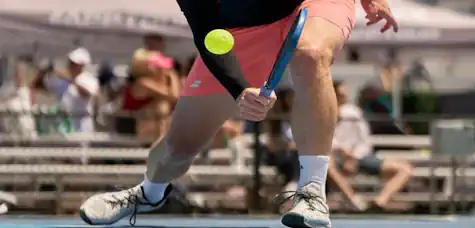
Key Strategies to Defend in Pickleball
Understanding the basics is the first step toward a formidable pickleball defense. Stand with your paddle up, ready to intercept your opponent’s shots and moving on. Keep in mind to:
Maintain the “ready position” with knees bent and weight on the balls of your feet.
Use your peripheral vision to track the ball and your opponent’s movements.
Anticipate shot placement based on your opponent’s body positioning and paddle angle.
Retreat to the baseline when necessary, defending against lobs and powerful drives.
Defense includes retreating and advancing when the opponent pushes or pulls their position.
Drill 1: King of the Hill – Covering Territory
The goal of this drill is to maintain control of the no-volley zone line while your opponent tries to win points by hitting the ball fast and low. It’s all about staying planted in your sweet spot and resisting the urge to chase the ball all over the court.
To set up the ‘King of the Hill’ exercise:
Mark the sidelines of the court at the seven-foot non-volley zone line.
With a partner or group, take turns hitting the ball low and fast over the net.
The defending player must return the ball in a way that prevents the opponent from gaining control of the point or hitting an easy winner.
Rotate positions regularly to ensure all players get a turn at both offense and defense.
The strategy is to keep the ball low and close to the net with enough speed to challenge your opponent but not to hit the ball so hard that it becomes unreturnable. The key is soft shots done with proper pickleball paddle position. The defender’s goal is to reach and return the ball with placement precision. This drill simulates real-game conditions where the ability to hold your ground with smart defensive plays is invaluable.
Drill 2: Cross-Court Showdown – Practicing Lateral Movement
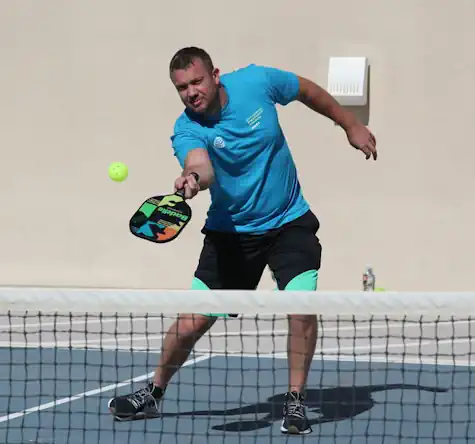
In pickleball, a significant portion of your defensive work involves covering the court’s lateral expanse, particularly when returning smashes and deep volleys. This drill sharpens your lateral movements and improves your reaction time. It also focuses on positioning footwork and shot selection in anticipating your opponent’s shots.
To begin the ‘Cross-Court Showdown’:
Divide the pickleball court in half lengthwise with a portable net or some tape.
Stand at the non-volley zone on one side with a partner or group.
Rally exclusively cross-court, aiming to keep the ball away from your opponent’s dominant hand.
Focus on quick lateral shuffles to reach wide balls, always maintaining a balanced and centered stance.
This drill emphasizes the necessity of being light on your feet and ready to move at a moment’s notice. Practicing cross-court shots also hones your accuracy, as you’ll need it to challenge your opponent to hit your opponents’ defense effectively.
Drill 3: 2 vs 1 – Overcoming the Odds
This final drill is excellent for training to play defense under pressure. By facing two opponents, you’ll develop the composure to handle challenging situations and come up with innovative defense strategies.
To engage in the ‘2 vs 1’ drill:
Divide into teams of two defenders against one attacker.
Rotate positions regularly so everyone has the opportunity to defend and attack.
The attackers aim to disrupt the defense with powerful shots that exploit weaknesses, while the defenders seek to communicate and cover for each other effectively.
The focus should be on quality over quantity, with defenders aiming for controlled and strategic returns.
This drill is less about winning points and more about honing teamwork, adaptability, and to how to communicate clearly to anticipate your opponent’s moves. By playing in a state of learning to adjust your play in response to the tactical offense, you’ll become a more rounded and composed defender.
Tips and Tweaks to Amp Up Your Pickleball Defense
Even the best drills need a bit of personal touch to truly impact your game. Here’s how to get the most out of these defensive exercises:
Record yourself practicing and review the footage for areas of improvement. Sometimes, seeing your moves on video can identify weaknesses that were not apparent from your perspective.
Focus on breathing. Maintaining a steady rhythm and deep breaths can help keep your nerves in check, especially during intense rallies.
Seek coaching and feedback. A second pair of eyes, especially with experienced players or coaches, can provide invaluable insights.
Conclusion: Defense Wins Championships – Drills Aren’t Just for On the Court
Practicing these pickleball drills isn’t merely about enhancing your defense; it’s also about improving your overall game. By internalizing the movements and strategies, you develop the instincts to protect your side of the court effectively. Remember, consistency is key. Regularly incorporating these defensive drills into your practice will pay off in tournaments and casual games alike. After all, a stellar defense can turn the tide of a game, making you not just a formidable rival but also a joy to play against. Keep those paddles up and those feet shuffling—your pickleball prowess awaits!
Frequently Asked Questions (FAQ)
How often should I practice these drills to see improvement?
Consistency is key. Try to incorporate these drills into your practice sessions at least 2-3 times a week. Remember, the goal is to develop muscle memory and adaptability on the court, which comes with regular practice. Learning to stay balanced and ready will improve your understanding of the flow of the game.
Can I practice these drills alone?
While some drills, especially the ‘King of the Hill’, are designed to be played with a partner or group, you can modify certain exercises for solo practice. For instance baseline to the kitchen below, using a ball machine or wall to return shots can help you work on your defensive stance, shot placement, keeping the ball in play, and the basics of defensive positioning.
What if I don’t have access to a pickleball court for practice?
Many of the skills these drills aim to improve, such as lateral movement and quick reactions, can be honed in a variety of spaces. Try adapting the drills for your backyard or a local park. The key elements to focus on are your stance, proper paddle position start readiness, and movement patterns. Keeping your feet shoulder-width apart, keeping your paddle in the proper position with elbows slightly bent, staying on the balls of your feet, and in a ready position.
How long does it typically take to see improvement in my pickleball defense?
Improvement varies from player to player based on their starting skill level, the frequency of practice, and their ability to adapt and internalize the drills. However, with consistent practice, many players begin to notice improvement in their defensive skills within a few weeks.
Are there any additional resources I can use to help with these drills?
Yes! There are numerous online resources, tutorial videos, and coaching clinics available that focus on defending in pickleball. Additionally, recording your practice sessions and reviewing your performance can be incredibly beneficial for identifying areas for improvement.
What non-verbal skills can be learned from these defense drills?
Defense drills in pickleball not only enhance physical abilities but also improve non-verbal signals, crucial for team play. Through drills like the ‘2 vs 1 – Overcoming the Odds,’ players learn to read their partners’ body language, predicting movements and strategic plays without a word being exchanged. This silent understanding between teammates improves coordination and allows you to react for seamless defense against opponents.
Additionally, these drills foster an intuitive sense of spatial awareness and the anticipation of opponents’ shots, skills that are invaluable during high-pressure matches. Practicing regularly with partners will naturally refine these non-verbal cues, making your team more formidable and in sync on the court. Disrupting your opponent’s rhythm will score you many an easy point in pickleball.
